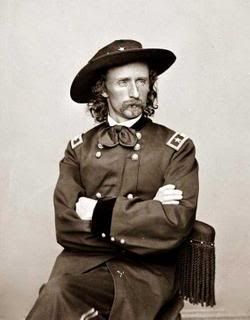Was losing Major Elliot’s strategic location during the extermination of the Southern Cheyenne Arapaho at Washita by Lieutenant Colonel Custer acceptable by U.S. military standards? Captain Benteen thought not.
“Surely some search will be made for our missing comrades” mocked Benteen’s piece, before concluding, “No, they are forgotten.”
Custer picked the wrong man to threaten horsewhipping.
Crossposted at Native American Netroots
One of Custer’s friends sent Custer a copy of this letter. Custer was enraged, and threatened to horsewhip the man who wrote it. Benteen admitted authorship, after which Custer dismissed him with a curt, “Colonel Benteen, sir, I’ll see you later!”
Custer never carried through on the threatened horsewhipping, and Bush never carried through with his threat to punish whoever leaked Libby’s name, either.
Mr. Bush said in 2003 that he would fire whoever leaked the information about Mrs. Plame’s identity.
Consequently, what a feeling of “I wish I’d known then what I know now” both of them might of felt. No, that would’ve meant either one would’ve ever regretted anything they ever said, unless it meant losing power.
The historical debate revolves around two questions: did Custer retreat on purpose, believing Lieutenant Godfrey about more encampments downstream, thus retreating for his own survival? Or, did Custer really not know where Major Elliot was?
A look at the map of the Washita Massacre reveals an answer.
Lieutenant Godfrey had told Custer there was more gunfire downstream, and Major Elliot was killed perhaps two miles from where Moxtaveto (“Black Kettle”) was. Custer and his men were on horseback. Was that too far to travel in snow on horseback, knowing the “enemies” were downstream and having heard a report of gunfire in that direction? How long would it have taken to ride that distance in those conditions? Twenty minutes? Less than forty?
A man commanding the military deserts his comrade troops and their need for safety in order to save himself and his public image for continuing a war. Imagine that.
Captain Benteen found Custer to be arrogant.
On January 29, 1867, Benteen met George Armstrong Custer, the Lieutenant Colonel of the regiment. Benteen disliked Custer almost immediately, finding him vain, arrogant and egotistical.
I can’t think of anyone commanding the military now who is “arrogant, vain, and egotistical,” who doesn’t give them the support they need and lets them die (yes I can).
That aside, there is another sense that is crucial in making sound judgments I believe: emotional intelligence.
I Think Captain Benteen displayed enough emotional intelligence –
Salovey and Mayer defined emotional intelligence as the: “Ability to monitor one’s own and other’s feelings and emotions, to discriminate among them and to use this information to guide one’s thinking and actions.”
– to be correct about both Custer’s character and Custer’s abandoning Major Elliot at Washita. Metaphorically, it doesn’t take much emotional intelligence to see it repeating now.
John (Fire) Lame Deer And Richard Erdoes. “Lame Deer, Seeker of Visions.” p. 95-96.And that’s what I want to talk about. Some of our young Indians have bumper stickers on their cars – “Custer Died For Your Sins!” – but I’m telling you, Custer is alive!
Indeed, and in the Whitehouse.
John (Fire) Lame Deer And Richard Erdoes. “Lame Deer, Seeker of Visions.” p.96.
• There’s a little Custer in all those sightseers, souvenir hunters, rock hounds, tourist scalpers, sharps and Deadwood hookers which cover these hills (Black Hills) like so many ants.
And there’s a little “Custer/Bush” in all the Congressman, Senators, lobbyists, neocons, and Religious Right who support and want the war, deny climate disintegration, and cover Capital Hill “like so many ants.”
A commenter who I agree with offered the following insights into this diary, which is a repost since “Today marks the anniversary of an iconic moment of American history: Custer’s Last Stand, the culmination of Lt. Col. George Armstrong Custer’s disastrous attack on a coalition of Lakota Sioux, Cheyenne and Arapaho Indians camped on the Little Bighorn River.” I wish to thank that person for giving a few corrections.
Ways not comparable:
Up until Little Big Horn, Armstrong had earned quite a bit of respect as a competent field commander, in comparison to other officers of the era, so let’s do compare.As for social attitudes of the era, Armstrong was not out of the main stream. Americans of the era if conversing with us now would eagerly classify the
Native Americans as “insurgent terrorists”, as primatives worthy only of extermination, or conversion, rather like so many Americans classify today’s extremist middle easterners.Armstrong had military live-fire experience and demonstrated battlefield leadership, versus W.
Armstrong was likely far more competent and intelligent as an officer, and usually was pretty realistic in what can be achieved, versus W.
No one questioned whether Armstrong was AWOL or away from duty posts.
Armstrong was articulate and conversant with tactics, strategies, and had real training.Armstrong made a few big choices that were bad, versus nearly the avalanache of W’s big choices that have gone bad. He may have arrogantly overestimated the value of his technological edge and the skilled execution his soldiers could perform.
Any general officer must be mindful of the social impact of their actions, yet not let it inhibit execution where specific ‘national interests’ are defined for him by the executive branch.
Might be interesting to compare W with Armstrong’s idea of staying the course



5 comments
Skip to comment form
Author
A real life historical example of American Exceptionalism. A giant of a man on whose shoulders stand current examples of exceptionalism.
Bush, for one…. :-/